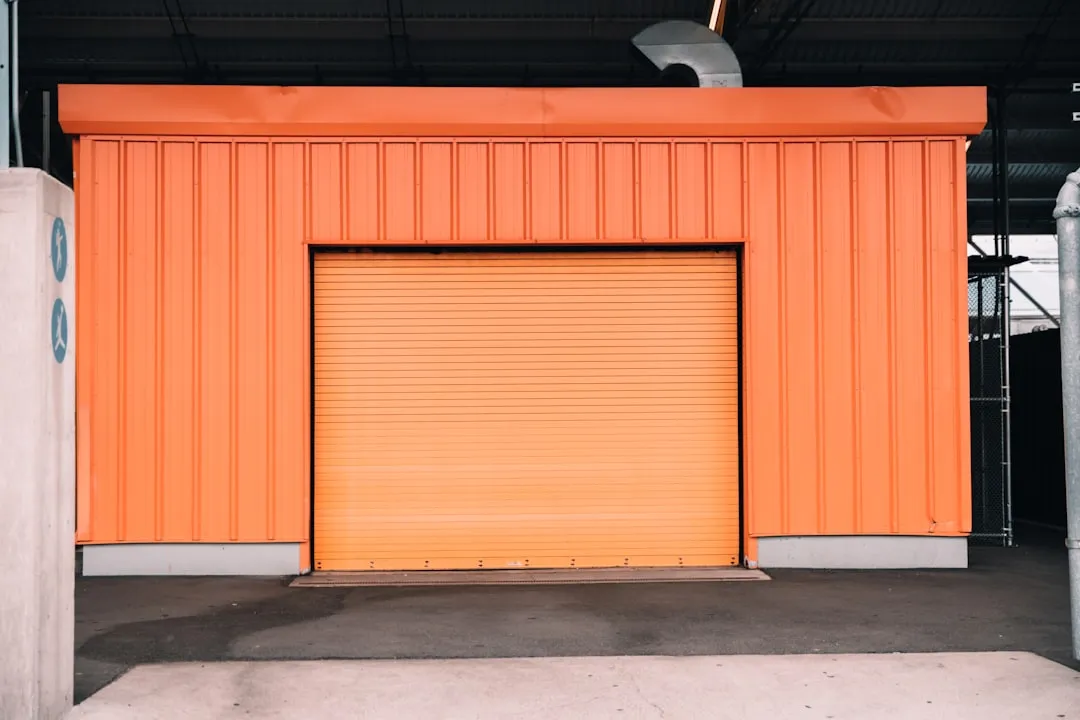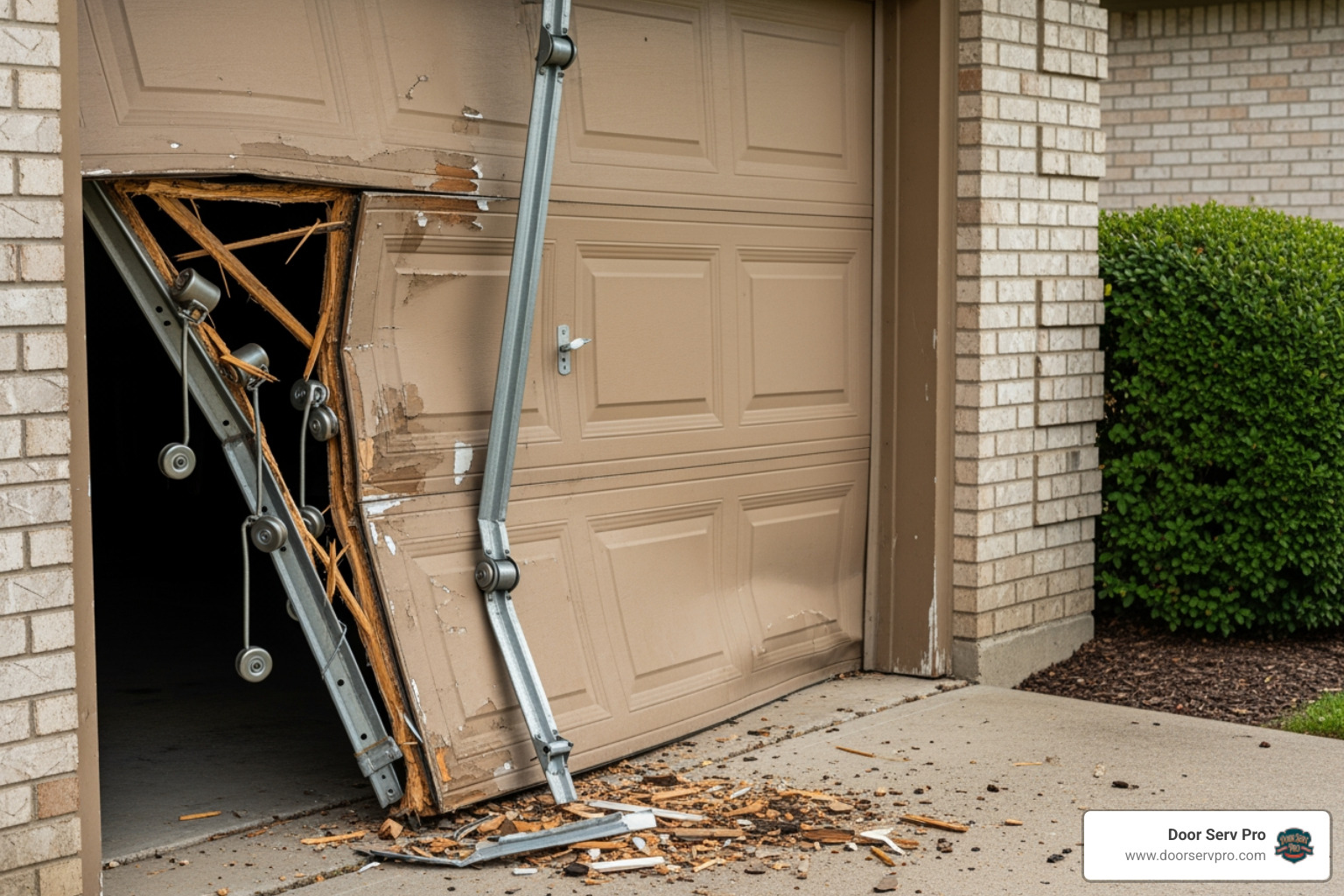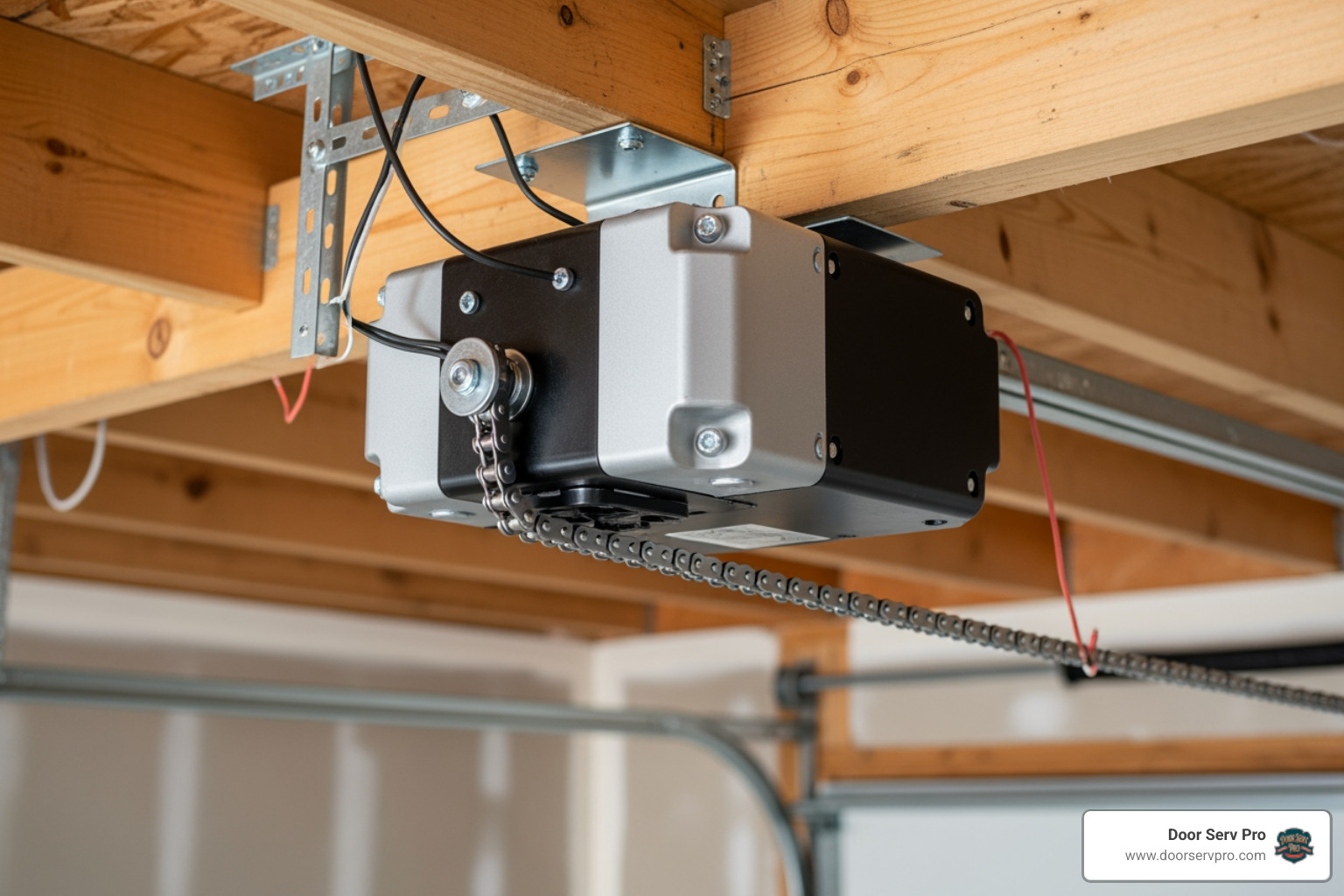Why Your Garage Door Seal Matters
A garage door weather seal is a weatherstripping system that fills gaps around your garage door to prevent water, drafts, pests, and debris from entering, helping to maintain a clean, dry, and comfortable garage.
Quick weatherproofing options for your garage door:
- Bottom seals - Attach to door bottom, compress against floor
- Threshold seals - Mount to garage floor, create raised barrier
- Perimeter seals - Seal sides and top of door frame
- Panel seals - Fill gaps between individual door sections
- Materials - PVC, rubber, and vinyl options for different climates
Why does this matter? Your garage door is one of the largest openings in your home. Without proper sealing, you're essentially leaving a window open to the elements year-round.
The benefits are immediate. Quality weather stripping prevents water damage, keeps out dirt and leaves, and blocks entry for rodents and insects. If your garage is attached to your home, proper sealing also improves energy efficiency by preventing conditioned air from escaping.
The signs you need new weatherstripping are easy to spot: daylight under your closed garage door, drafts around the edges, or water puddles after rain. These gaps are open invitations for pests.
Quality weather stripping should last two to three years, but extreme temperatures can shorten this lifespan. The good news? Most seals are designed for easy DIY installation, though professional installation ensures optimal performance.
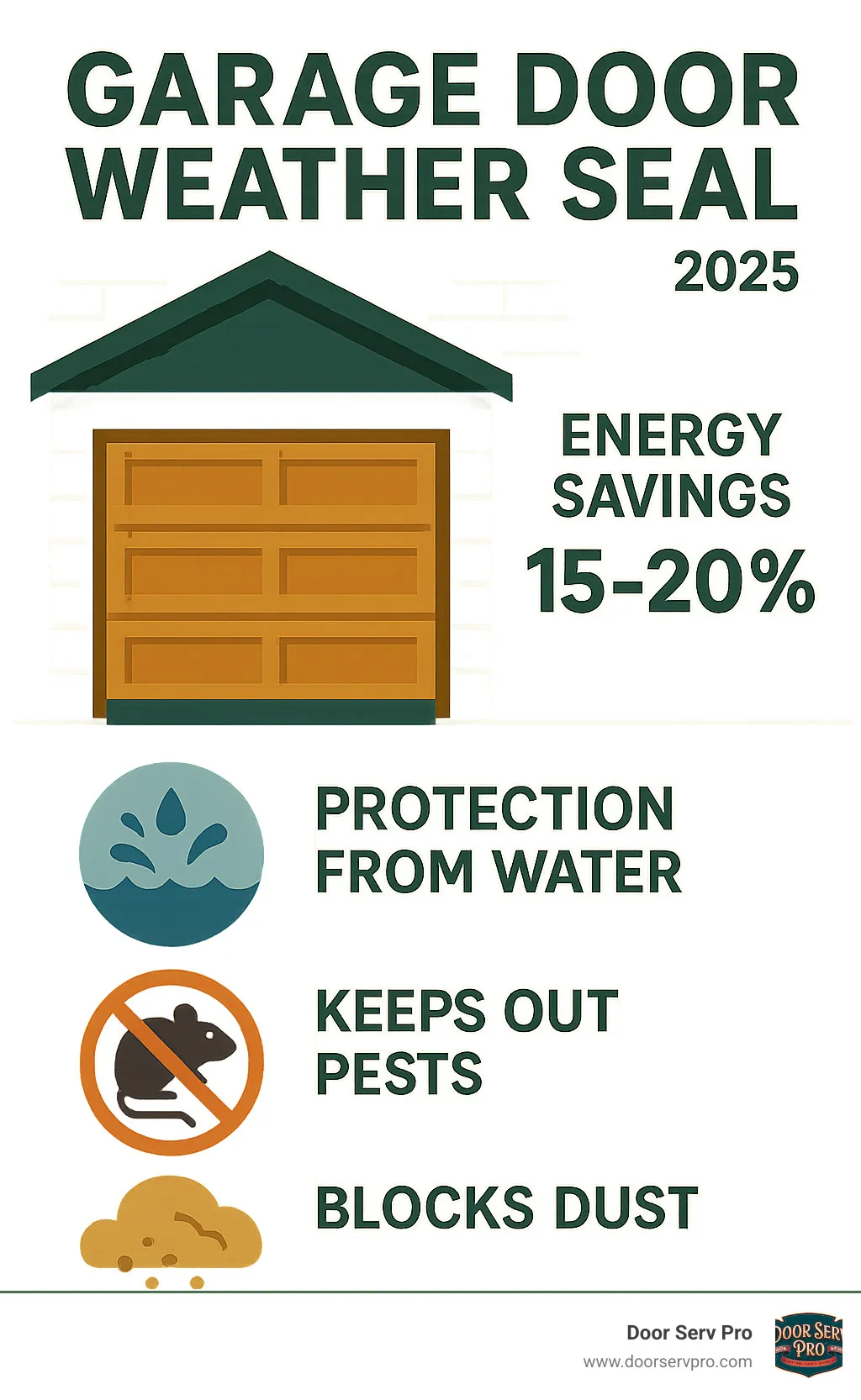
Understanding Your Garage Door Weather Seal: Types and Materials
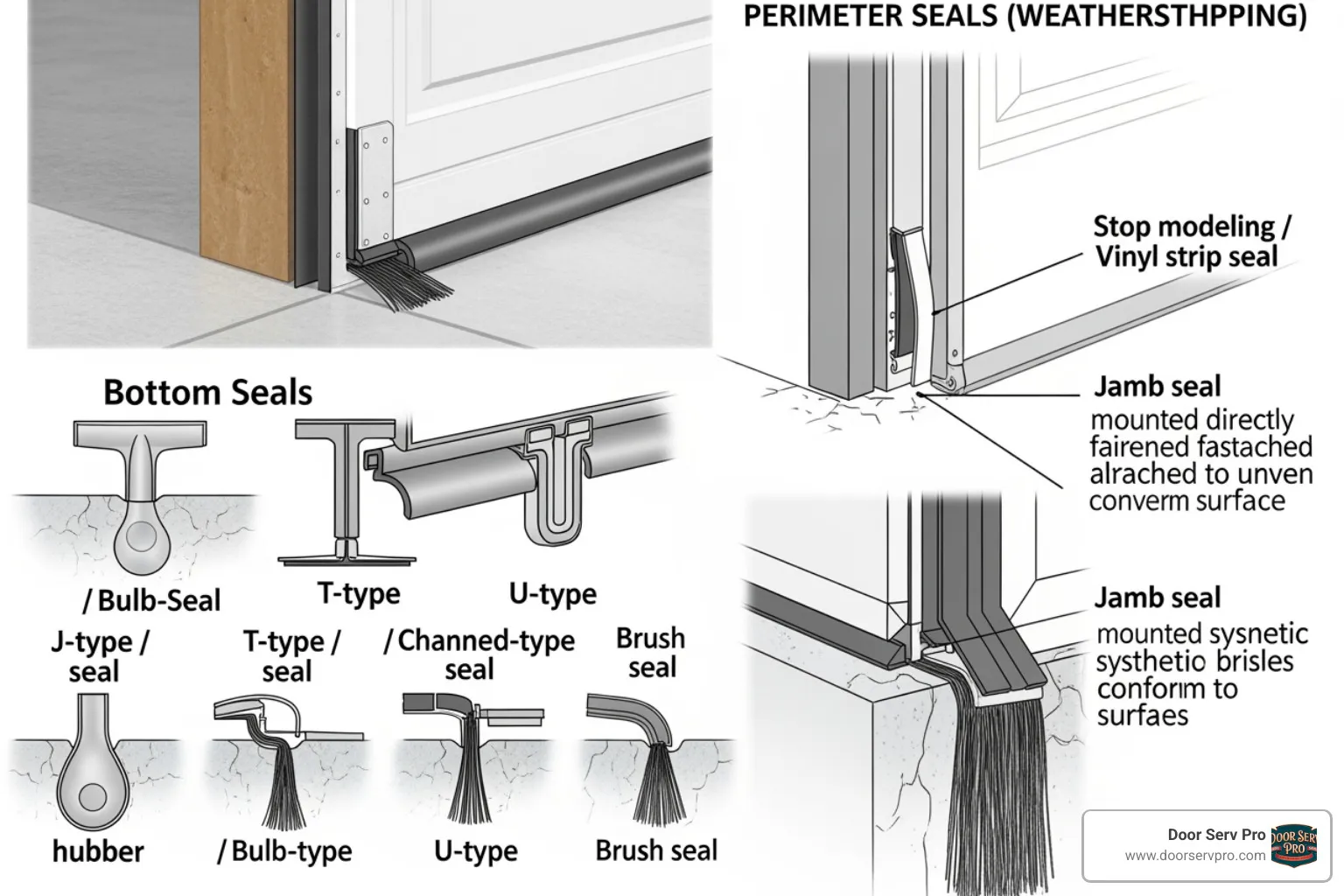
Think of your garage door's weather protection as a complete system. A garage door weather seal protects all four sides of the opening, plus the spaces between panels. Whether for a residential or commercial garage, understanding these different seal types will help you choose the right protection.
Bottom Seals
Your garage door's bottom edge takes a constant beating, which is why choosing the right bottom weatherstripping is so important.
T-style seals are a popular choice. They slide into a retainer track at the door's bottom, where T-shaped edges lock them securely in place. The rubber or vinyl body then compresses against the garage floor to create a tight seal.
U-shaped seals (or astragal seals) create two contact points with the floor, making them great for uneven concrete. Wood garage doors might need a metal gasket channel to hold these seals.
Beaded seals have a round bead that slides into the retainer and are effective for newer doors with properly aligned retainer channels.
Quality seals can work in extreme temperatures, some down to an incredible -62°F. Most come in lengths suitable for single or double-car garage doors.
Threshold Seals
While a bottom seal attaches to the door, a garage door threshold seal is glued directly to the garage floor. It creates a small raised barrier that the door's bottom seal presses against.
This setup is brilliant for water diversion. The raised barrier redirects water away from your garage interior, which is especially helpful if your driveway slopes toward your garage.
The pest control benefits are equally impressive. Mice and insects have a much harder time squeezing through when both a bottom seal and a threshold seal work together.
For garages with uneven floors, threshold seals can save the day by creating a consistent, raised surface for the door to seal against.
Many quality threshold seals include anti-slip ridges and high-visibility safety strips (usually bright yellow). These are typically made from marine-grade PVC that's tough enough for daily vehicle traffic.
Stop Molding and Perimeter Seals
The sides and top of your garage door frame also need sealing. This is where perimeter seals come in, which are crucial for complete protection.
Jamb seals run along both sides and across the top of the door frame. They have flexible flaps that press against the garage door when it closes, blocking wind and rain.
Vinyl door stops with integrated weatherstrip are a clever option that combines the structural stop with a flexible sealing flap, creating an airtight seal and a finished, professional look.
For colder climates, Arctic vinyl weatherstripping stays flexible when regular vinyl might stiffen and lose its sealing ability.
These perimeter seals are essential for preventing energy loss and keeping debris from blowing into your garage.
Panel and Joint Seals
Most garage doors have multiple horizontal panels. While newer doors often have interlocking edges, older doors—especially wood ones—can have significant gaps between panels that need sealing.
Interlok joint seals are designed to fill these gaps. They fit between door sections and compress when the panels close, preventing air intrusion.
V-shaped panel weatherstripping is a simpler, self-adhesive strip that applies to panel edges, making it useful for flat-edged wood doors.
These seals ensure your entire door surface acts as one continuous barrier.
Common Materials: PVC vs. Rubber vs. Vinyl
The material of your garage door weather seal determines its lifespan and performance. Each option has distinct advantages.
PVC is incredibly durable and flexible, resisting UV damage and moisture. It won't rust, maintains its color, and is easy to cut. Marine-grade PVC used in threshold seals can handle vehicle traffic for years.
Rubber remains a top choice for its exceptional flexibility, allowing it to conform to irregular surfaces. Quality rubber seals can function in extreme temperatures (down to -62°F), but can become brittle with age and UV exposure.
Vinyl is often a budget-friendly solution that offers excellent performance. It's moisture-resistant and ideal for integrated weatherstripping on door stops, though some types may stiffen in very cold weather.
The key is matching the material to your climate and application. Quality materials always provide better long-term value than cheaper alternatives that need frequent replacement.
Choosing and Installing Your Weatherstripping
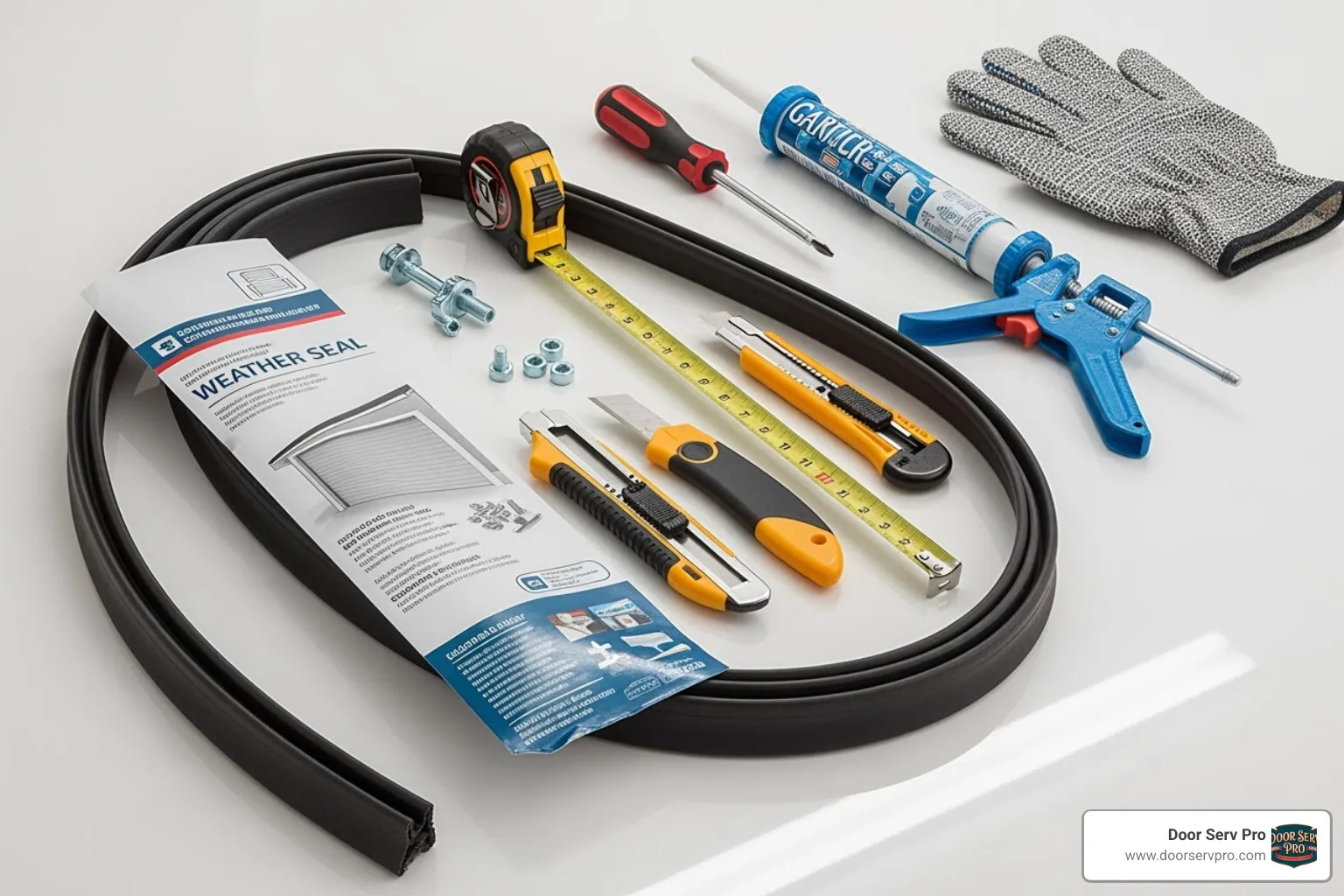
Ready to seal up your garage? Choosing the right garage door weather seal and installing it properly is key. The wrong seal is ineffective, while the right one creates a fortress against the elements. Most installations are doable weekend projects, but knowing when to call a pro can save you headaches.
Choosing the Right Garage Door Weather Seal for Your Home
Choosing the right weatherstripping requires matching a few key factors to your garage and local weather.
Climate is your biggest consideration. For brutal winters, you'll want materials like Arctic vinyl or specialized rubber that stay flexible in the cold, some working down to -62°F. Conversely, in extreme summer heat, look for seals that won't soften or degrade.
Your door type matters too. Some bottom seals need specific retainer channels to work. An older garage door with flat panels might need different weatherstripping than a modern sectional door.
Gap size is crucial. Measure the spaces around your door. Some seals handle big gaps well, while others are for tight fits. A threshold seal is a great solution for bridging uneven spots on your garage floor.
Material choice comes down to PVC, rubber, or vinyl. PVC offers great durability, rubber gives you excellent flexibility, and vinyl often provides a good balance of performance and affordability.
Quality features can make a real difference. Threshold seals with anti-slip ridges and high-visibility strips are important safety features. Some premium products even come with lifetime warranties.
A Step-by-Step Installation Guide
Installing garage door weather stripping is like following a recipe—get the steps right for a great result. Rushing or skipping steps can lead to a poor seal.
Before you start, gather your tools. You'll need a utility knife, measuring tape, drill, screwdriver, and cleaning supplies. For threshold seals, add a caulking gun and adhesive.
Surface preparation is absolutely critical. Clean every surface where the seal will attach. Remove old adhesive, scrape off debris, and ensure everything is dry. A clean surface is the difference between a seal that lasts for years and one that fails quickly.
Removing old weatherstripping can be tedious, but it's worth doing right. Use a putty knife or scraper for stubborn bits.
Cutting your new seal requires precision. Measure twice, cut once. For bottom seals, cutting a little extra gives you room to trim for a perfect fit.
Installing bottom seals is often easier with two people. A little dish soap or silicone spray helps the seal slide smoothly into the retainer channel.
Threshold seals need special attention. Position the seal, mark its location, apply the adhesive, and press it into place. Resist driving over it until the adhesive fully cures.
Perimeter seals require precise positioning so the weatherstrip compresses properly against the door. Fasten them with galvanized nails or screws.
For visual learners, you can Watch Step-by-Step Installation videos that walk you through the process.
DIY or Hire a Professional?
Should you do it yourself or hire a professional? The answer depends on your comfort level, available time, and how perfect you want the results to be.
Simple jobs like replacing basic bottom seals are great DIY projects. If you're handy with basic tools, these installations are forgiving and easy to fix.
More complex installations like threshold seals on uneven floors or perimeter seals that require precise cuts can be trickier. Professional experience makes a difference here.
Time is a real factor. What looks like a quick job can easily turn into an all-day project if you run into unexpected issues.
Safety should always be your top concern. Working around heavy garage doors requires caution. If your installation involves anything near the bottom brackets or spring systems, that's definitely professional territory.
The perfect fit factor is where professionals really shine. With over 25 years in business, we know how to handle the quirks every garage has, like an uneven floor or a slightly misaligned door frame.
At Door Serv Pro, we're happy to evaluate your situation and provide a free written estimate. We can advise whether it's a good DIY job or if professional installation would yield better long-term results.
Maintenance, Lifespan, and When to Replace
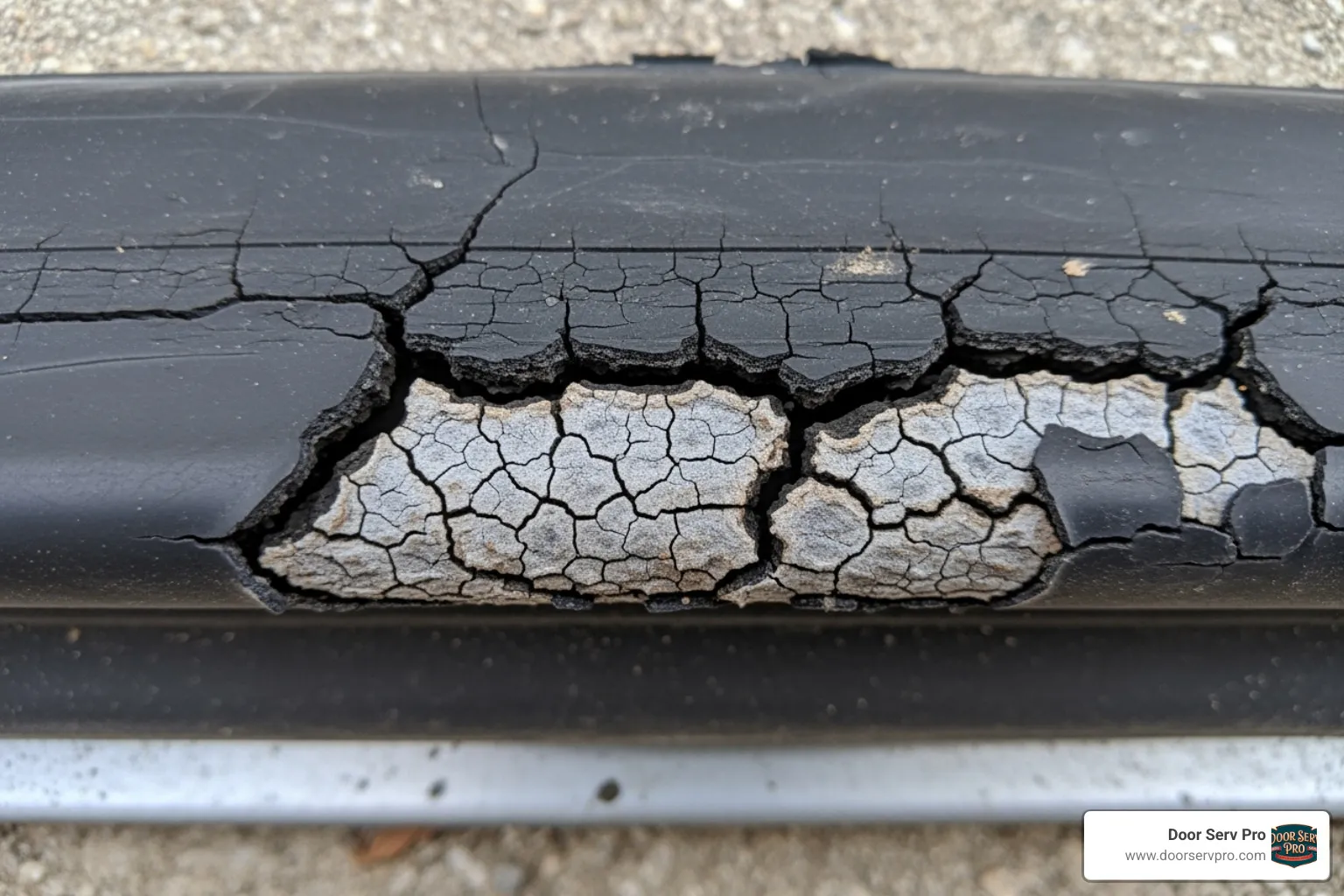
Your garage door weather seal works hard every day and will eventually need replacing. With a little attention, you can get the most out of your weatherstripping and know exactly when it's time for a new one.
Signs It's Time to Replace Your Garage Door Weather Seal
Your garage will tell you what's wrong—you just need to know what to look for.
- Visible damage: Look for cracks, tears, or sections that have pulled away from the door or frame.
- Brittleness: Stiff, hard weatherstripping has lost its ability to compress and conform to surfaces.
- Daylight: Stand inside your garage with the door closed. If you see light peeking through, you have gaps that let in water, drafts, and pests.
- Water puddles: If you find damp spots or puddles along the door's perimeter after rain, your seal isn't working.
- Drafts: Feeling air movement near the closed door on a windy day means your seals are failing and costing you energy.
- Pest problems: A sudden increase in rodents or insects can often be traced back to failing weather seals.
Lifespan and Maintenance Tips
Most garage door weather seals last for two to three years, though high-quality materials can extend this. Some premium threshold seals even come with lifetime warranties.
The secret to a long lifespan is simple maintenance:
- Keep seals clean: Wipe them down with a damp cloth and mild soap every few months to remove dirt and grime.
- Lubricate them: Use a silicone-based lubricant to keep rubber and vinyl seals flexible and prevent cracking. Avoid petroleum-based products.
- Choose the right material: Weather extremes are the biggest enemy. Extreme cold makes seals stiff, while extreme heat and UV exposure make them brittle. Quality materials like Arctic vinyl and UV-resistant PVC are designed to handle these conditions.
A little proactive care goes a long way in keeping your garage comfortable and dry.
Frequently Asked Questions about Garage Door Weather Seals
When homeowners consider garage door weather seals, they often have questions. After helping thousands of customers over our 25 years in business, we've compiled answers to the most common concerns.
Can new weather stripping really improve my garage's energy efficiency?
Absolutely! A properly installed garage door weather seal can make a noticeable difference in your energy bills, especially if your garage is attached and insulated. Your garage door is a giant opening in your home's thermal envelope. Without a proper seal, conditioned air escapes and outside air enters, forcing your HVAC system to work harder. By creating an airtight seal, you prevent this air exchange, leading to more stable temperatures and reduced energy costs.
How does a threshold seal differ from a bottom seal?
This is a common point of confusion. The key difference is where they're installed and how they function.
A bottom seal attaches directly to the bottom edge of your garage door. It compresses against the floor when the door closes.
A threshold seal is permanently adhered to your garage floor. It creates a raised barrier that the bottom seal presses against for an even tighter seal.
Why choose a threshold seal? It offers superior protection against driving rain and is excellent for uneven concrete floors where a bottom seal alone might leave gaps. Using both types together provides the ultimate protection.
What is the best material for a garage door seal in a climate with extreme temperatures?
In areas like West Virginia, Virginia, Pennsylvania, and Maryland, temperature swings are extreme. Your garage door weather seal needs to handle both sweltering heat and bitter cold without failing.
For these conditions, we recommend high-quality PVC or specially formulated rubber materials. These are engineered to remain flexible across a wide temperature range.
- Arctic vinyl is our go-to for cold climates, as it stays flexible down to an incredible -62°F when other materials might crack.
- PVC offers excellent all-around performance, resisting both temperature extremes and UV damage.
- Rubber gaskets also work well, conforming beautifully to uneven surfaces.
The bottom line? Quality matters more than the specific material type. A well-made seal will outperform a cheap alternative. Investing in quality weatherstripping is about protecting your garage and home from the elements year after year, especially in a climate with extreme temperatures.
Secure Your Garage with Expert Weather Seal Services
You now understand the types of garage door weather seals, the signs of wear, and the basics of installation. You know what it takes to protect your garage from the elements.
But knowing the theory doesn't always make the job easy. A properly installed garage door weather seal is a small component that delivers massive results, changing your garage by keeping the elements out, lowering energy bills, and deterring pests.
The real magic is in the details, and getting a perfect fit is where professional expertise makes all the difference. At Door Serv Pro, we've been perfecting garage door sealing for over 25 years. Our NATE-certified team assesses your specific situation, recommends the right materials for your climate, and ensures every seal works as a complete system.
When should you call us? If you see daylight, feel drafts, or find puddles, it's time for action. We'll provide a thorough assessment and a free written quotation.
Founded by industry veteran Paul Wiese, our family-owned company brings a personal touch to every project. We're not just fixing seals; we're protecting your home and peace of mind with a 100% satisfaction guarantee and round-the-clock service.
We're proud to serve communities across WV, VA, PA, and MD. At Door Serv Pro, we don't just fix doors—we create lasting impressions, one perfectly sealed garage at a time.
Schedule your garage door maintenance in Winchester, VA today!

